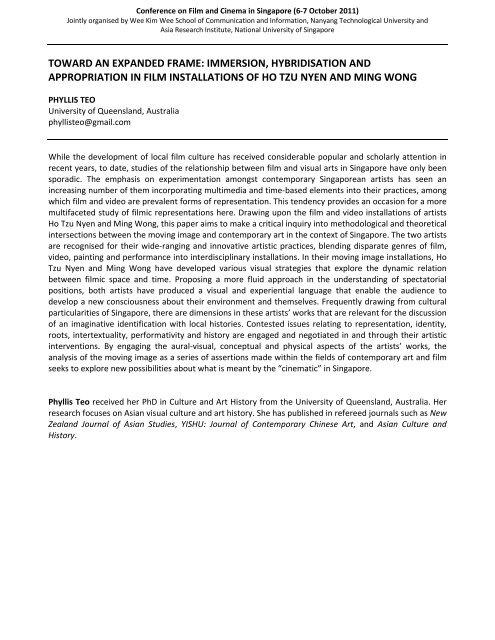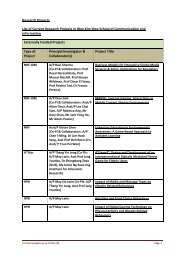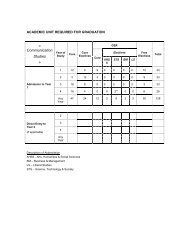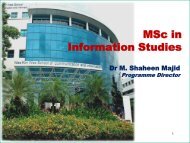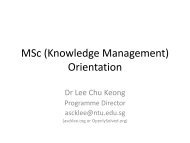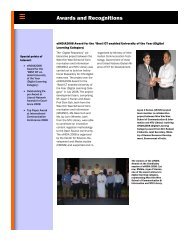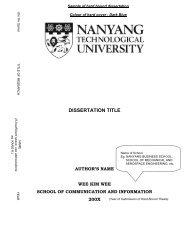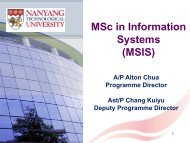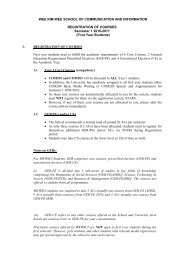Programme and Abstracts 4 Oct 2011 - WKWSCI Home - Nanyang ...
Programme and Abstracts 4 Oct 2011 - WKWSCI Home - Nanyang ...
Programme and Abstracts 4 Oct 2011 - WKWSCI Home - Nanyang ...
Create successful ePaper yourself
Turn your PDF publications into a flip-book with our unique Google optimized e-Paper software.
Conference on Film <strong>and</strong> Cinema in Singapore (6‐7 <strong>Oct</strong>ober <strong>2011</strong>)<br />
Jointly organised by Wee Kim Wee School of Communication <strong>and</strong> Information, <strong>Nanyang</strong> Technological University <strong>and</strong><br />
Asia Research Institute, National University of Singapore<br />
TOWARD AN EXPANDED FRAME: IMMERSION, HYBRIDISATION AND<br />
APPROPRIATION IN FILM INSTALLATIONS OF HO TZU NYEN AND MING WONG<br />
PHYLLIS TEO<br />
University of Queensl<strong>and</strong>, Australia<br />
phyllisteo@gmail.com<br />
While the development of local film culture has received considerable popular <strong>and</strong> scholarly attention in<br />
recent years, to date, studies of the relationship between film <strong>and</strong> visual arts in Singapore have only been<br />
sporadic. The emphasis on experimentation amongst contemporary Singaporean artists has seen an<br />
increasing number of them incorporating multimedia <strong>and</strong> time‐based elements into their practices, among<br />
which film <strong>and</strong> video are prevalent forms of representation. This tendency provides an occasion for a more<br />
multifaceted study of filmic representations here. Drawing upon the film <strong>and</strong> video installations of artists<br />
Ho Tzu Nyen <strong>and</strong> Ming Wong, this paper aims to make a critical inquiry into methodological <strong>and</strong> theoretical<br />
intersections between the moving image <strong>and</strong> contemporary art in the context of Singapore. The two artists<br />
are recognised for their wide‐ranging <strong>and</strong> innovative artistic practices, blending disparate genres of film,<br />
video, painting <strong>and</strong> performance into interdisciplinary installations. In their moving image installations, Ho<br />
Tzu Nyen <strong>and</strong> Ming Wong have developed various visual strategies that explore the dynamic relation<br />
between filmic space <strong>and</strong> time. Proposing a more fluid approach in the underst<strong>and</strong>ing of spectatorial<br />
positions, both artists have produced a visual <strong>and</strong> experiential language that enable the audience to<br />
develop a new consciousness about their environment <strong>and</strong> themselves. Frequently drawing from cultural<br />
particularities of Singapore, there are dimensions in these artists’ works that are relevant for the discussion<br />
of an imaginative identification with local histories. Contested issues relating to representation, identity,<br />
roots, intertextuality, performativity <strong>and</strong> history are engaged <strong>and</strong> negotiated in <strong>and</strong> through their artistic<br />
interventions. By engaging the aural‐visual, conceptual <strong>and</strong> physical aspects of the artists’ works, the<br />
analysis of the moving image as a series of assertions made within the fields of contemporary art <strong>and</strong> film<br />
seeks to explore new possibilities about what is meant by the “cinematic” in Singapore.<br />
Phyllis Teo received her PhD in Culture <strong>and</strong> Art History from the University of Queensl<strong>and</strong>, Australia. Her<br />
research focuses on Asian visual culture <strong>and</strong> art history. She has published in refereed journals such as New<br />
Zeal<strong>and</strong> Journal of Asian Studies, YISHU: Journal of Contemporary Chinese Art, <strong>and</strong> Asian Culture <strong>and</strong><br />
History.


